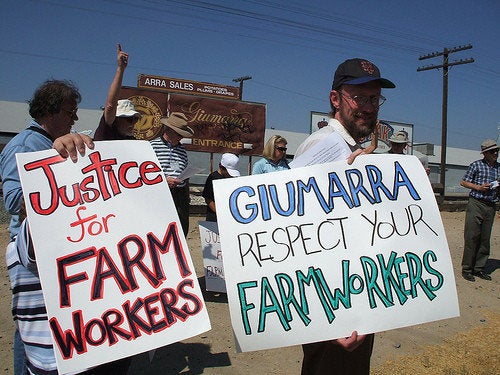
By Eduardo Stanley
FRESNO - No one knows the exact number of farm workers who year after year raise and harvest the crops grown in the Central Valley of California and which earn an estimated $18 billion annually.
Farms in this vast geographic area produce a varied selection of crops, ranging from grapes to nuts, from corn to strawberries. Dominant economic forces try to keep the price of these products low to maintain and increase consumption, while also confronting the growing threat of competition from abroad. This all leads to keeping wages low for field workers, the weakest link in the production chain.
To this end, farm owners use different tactics. For example, piecemeal or “contracted” work is paid per bucket of oranges or cranberries, not by the hour. Using this system, the workload ratchets up in intensity as laborers hustle and scramble to fill enough buckets and equate to the legal minimum wage of $8 an hour. It is a feat they rarely achieve.
“In tomato-picking, the worker follows the tractor and cannot fall behind,” explains Juan Santiago, a 23-year-old farm worker from Madera, Calif. “The ‘tomateros’ work very hard and can earn about $120 a day.”
Although that daily $120 sounds attractive to underpaid laborers, the harsh reality puts things in perspective. “This job lasts about three months,” said Santiago, who at 23 seems to know each row in the Central Valley. “In general, most field workers make about $11,000 annually.”
The problem is that farm workers, who don’t know the labor laws or the worker rights delineated by them, are at the mercy of contractors. What’s more, they lack any organizational structure to represent them. For example, isntead of receiving at least the $8 per hour minimum wage under California law, most farm labor is paid at “piece rate,” or “contracted.”
“This system is [designed] to increase worker productivity while reducing pay for working too slowly,” said Luis Magana, an activist with the American Friends Service Committee of Stockton, Calif. “For example, onion producers pay 80 cents per person (per bag or sack), so a family of three can earn $60 a day; divide that by three [people] and it’s a mere $20.”
“On the ‘table,’ the [grape producers] pay 45 cents for each one,” Santiago said. The “table” is actually just a large sheet of paper where the laborer places the grapes collected to dry beneath the sunlight, after which they are processed and cleaned, transforming them into flavorful, aromatic raisins. Field laborers must work intensely to collect sufficient “tables” for them to earn a decent wage.
A field laborer can collect about 12 “tables” an hour – in other words $5.40 an hour. That too is less than the legal $8 minimum wage, and laborers are not paid overtime.
“The law says that the worker is to receive the minimum salary,” Magana says, “but nobody pays it and nobody claims it.”
Because of a lack of organization and a group consciousness, the field laborer looks for the individual way out. “Many workers prefer the ‘contract’ pay because they think that they’ll make more money in less time, but the reality is different,” according to Magana. “In general, based on my experience and knowledge, a field laborer earns about $10,000 a year.”
Santiago draws a similar conclusion. “There are exceptions, but generally that is the income for a Central Valley field worker.” He says the salary system in the field “is chaotic.” Sometimes the pay is ‘contractual’ and other times by the hour, something producers decide based on their own financial interests.
“The field worker doesn’t raise his voice nor seeks to organize,” Magana says. “[The worker] also doesn’t know the struggles of the 1960s and ’70s.”
Since then, the “illegal” status of the majority of field laborers contributes to their trepidation in claiming labor rights, just salaries and organizing as a united front. Santiago ponders for several seconds before continuing, almost resisting, but finally says, “There’s just not much interest” in organization among field laborers.
According to Magana, workers themselves don’t even know who Cesar Chavez is. Chavez was the leader and co-founder of the farm workers’ labor union known as the United Farm Workers, which was founded in the 1960s in the Central Valley.
The union galvanized its resolved during legendary battles with farm owners, successfully winning benefits such as a minimum wage, the right to unionize, restrooms and drinking water at labor camps. Nearly 30 years later, little, if anything is left of this fight. Meanwhile, field laborers are working overtime for less than minimum wage and at the mercy of global forces which conspire to keep things as they are.
Born in Rosario, Argentina, Eduardo Stanley graduated from the School of Fine Arts (cinematography) of the National University of La Plata in Buenos Aires and went on to do post-graduate work in communications theory at the University of Bucharest in Romania. For three years, he taught logic and semiotics at the Autonomous University of Sinaloa in Culiacan, Sinaloa, Mexico.
Stanley moved to the United States in the mid-1980s. In more than 25 years of news journalism and research, he has investigated California’s Central Valley, working primarily in Spanish for various media outlets. He is the current editor of “El Sol,” a Spanish-language division of the “Visalia Times-Delta,” in Visalia, Calif., as well as a collaborator for several national and international publications.
Flickr photo by National Farm Worker Ministry